Thursday 3rd June – Home – Now getting two eggs per day. Ginger is still laying small eggs, although a reasonable sized one was in the nest box this morning. However, whose is it? There was a very decent sized egg laid sometime after lunch yesterday but no idea who was responsible. Ginger was in the nest box earlier this morning but Goldie emerged when some radish tops were given and there was one large egg. The radishes have been a disappointment, their roots have not swollen at all. The runner beans are now climbing the bamboo poles, chard and parsley has germinated and the French beans are growing slowly.
Fleets Dam – The afternoon is hot and humid. Round the fields that were levelled some years ago, supposedly for sports pitches but they are now white clover covered meadows. The Elderflowers are almost finished but I gather enough for another couple of litres of cordial. There are at least four Great Crested Grebes on the lake, all adults. A Grey Heron stands atop one of the water purifying machines. I arrive back home just as a thunderstorm breaks and torrential rain falls. The sun returns after about fifteen minutes.
Friday 4th July – Stocksmoor-Thunderbridge – Off the train at Stocksmoor and along the road towards Thunderbridge. Black Dick’s Tower sits on its hill across 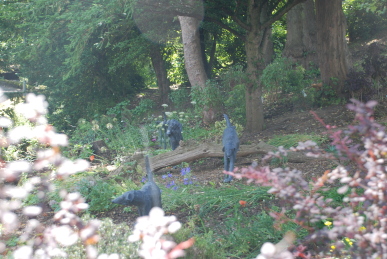 the fields. It is warm and sunny, a delightful July day. Foxgloves are in full bloom everywhere, occasionally a small patch of white ones. The idea of the trumpet flowers being used as gloves by foxes is sweet, but in fact “fox” is a corruption of “folk” referring to the fairy folk who were supposed to use the flowers as gloves. The road, Birks Lane drops down the hill through Birks Wood past Birks Cottage and then a splendid country house, Birks Gate. The garden leads down to a stream, Shepley Dike. Statues of hunting hounds stand in the trees by the stream. The road crosses the bridge which gives the hamlet its name. It is possible that the name is Old English meaning a bridge dedicated to the god Thunor. One side of the bridge has “Thurstonland” carved into the stone, although it is very eroded and Shelley, picked out in paint at the other end, indicating the directions of the road. Some of the house names reflect their old uses, The Grange, Corn Mill, Well House etc. The main building is the Woodman Inn, formerly The Boot and Shoe. Thundergate leads up out of the village past a large sandstone quarry now used as the pub car park. Trees are now, of course in full leaf and the whole valley is brilliantly green with the odd flash of dark red from a Copper Beech. A Chiffchaff is calling from the woods; sheep baa in the distance; a Jay hops down to the road and then back up into the leaves.
the fields. It is warm and sunny, a delightful July day. Foxgloves are in full bloom everywhere, occasionally a small patch of white ones. The idea of the trumpet flowers being used as gloves by foxes is sweet, but in fact “fox” is a corruption of “folk” referring to the fairy folk who were supposed to use the flowers as gloves. The road, Birks Lane drops down the hill through Birks Wood past Birks Cottage and then a splendid country house, Birks Gate. The garden leads down to a stream, Shepley Dike. Statues of hunting hounds stand in the trees by the stream. The road crosses the bridge which gives the hamlet its name. It is possible that the name is Old English meaning a bridge dedicated to the god Thunor. One side of the bridge has “Thurstonland” carved into the stone, although it is very eroded and Shelley, picked out in paint at the other end, indicating the directions of the road. Some of the house names reflect their old uses, The Grange, Corn Mill, Well House etc. The main building is the Woodman Inn, formerly The Boot and Shoe. Thundergate leads up out of the village past a large sandstone quarry now used as the pub car park. Trees are now, of course in full leaf and the whole valley is brilliantly green with the odd flash of dark red from a Copper Beech. A Chiffchaff is calling from the woods; sheep baa in the distance; a Jay hops down to the road and then back up into the leaves.
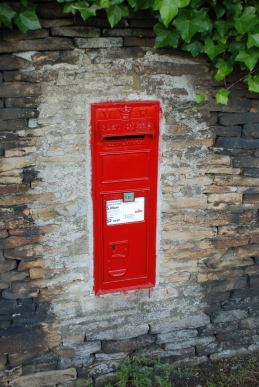
Kirkburton – The road joins the main Huddersfield Road, the A629 and a lane leads north through Causey Foot. A bright red Victorian post box is set into the wall – how much longer will these exist before the champions of competition decide they are anachronisms that can be done away with? On the junction is a large stone post indicating the way to Huddersfield, Kirkburton, Shepley etc. Up the lane is a public bridleway which runs between two fields of six inch high sweet corn. The path had once been flagged with sandstone and was called Shaw Lane until at least the beginning of the Second World War. The lane leads into Kirkburton, Low Town. Steps lead up to a lych-gate and into the graveyard of All Hallows Church. The 1854 map indicates the church was called St John’s, yet all other evidence points to it being dedicated to the Holy Trinity and called All Hallows for some considerable time. The church was established by charter in 1147, although it seems the church was built around 1190 and rebuilt in early 13th century. Within the church is a 10th century cross, indicating a religious presence before the 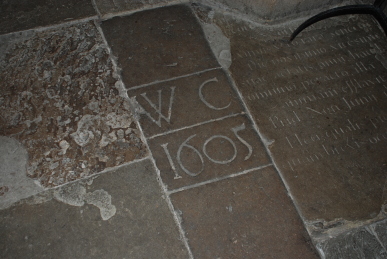 Conquest. The west doorway is Early English Style whilst the tower is 15th century Perpendicular Style. Much of the rest of the church was reconstructed in the 19th century. The nave has a fine mediaeval ceiling with coloured bosses. A magnificent font cover depicts The Lord with a child, designed by Sir Charles Nicholson in 1931. There is some good Victorian glass in the chancel windows and the East Window is dated from 1938 and 1962. A simple gravestone in the floor is inscribed WC 1605. A list of vicars is on the wall, starting with Richard de Birstall in 1230, although it is thought he was the incumbent since the 1180s. In 1615 the vicar was Gamaliel Whitaker who was gaoled during the Civil War and died in prison; his wife is said to have been murdered by Parliamentarian soldiers. Joseph Briggs served for an extraordinary 65 years between 1662 and 1727, whilst his successor, Robert d’Oyley was said to have visited the church only three times during his 39 year tenure. (Information from a leaflet written by Robert Carter available in the church.)
Conquest. The west doorway is Early English Style whilst the tower is 15th century Perpendicular Style. Much of the rest of the church was reconstructed in the 19th century. The nave has a fine mediaeval ceiling with coloured bosses. A magnificent font cover depicts The Lord with a child, designed by Sir Charles Nicholson in 1931. There is some good Victorian glass in the chancel windows and the East Window is dated from 1938 and 1962. A simple gravestone in the floor is inscribed WC 1605. A list of vicars is on the wall, starting with Richard de Birstall in 1230, although it is thought he was the incumbent since the 1180s. In 1615 the vicar was Gamaliel Whitaker who was gaoled during the Civil War and died in prison; his wife is said to have been murdered by Parliamentarian soldiers. Joseph Briggs served for an extraordinary 65 years between 1662 and 1727, whilst his successor, Robert d’Oyley was said to have visited the church only three times during his 39 year tenure. (Information from a leaflet written by Robert Carter available in the church.)
Shelley – From the church I head up past the ornate stone arch of the entrance to the graveyard and down a bridleway, Box Ings Lane. Again there is old flagstones in the path. To one side is a long recently landscaped garden. The path leads through Shelley Wood. An sign points across a field towards Shelley, stating it is the “Shelley Welly Walk”. However, the path peters out in the field and there is no indication of the route. By luck I find a set of steps leading up to the A629. A large sprawling “bungalow town” eventually passes onto some rather more pleasant Victorian villas. A steep hill climbs Far Bank, past the Post Office to what is supposed to be the village centre. Private houses again reveal the buildings’ origins, The Old Drapery, The Bakehouse and a set of apartments with “Rock Ales” high on the gable end. Down Near Bank, past a house being refurbished. Astonishingly a crown top chimney pot has been thrown into a skip.
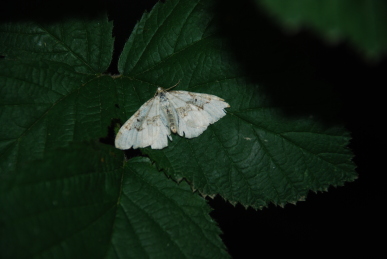
Shepley –The road becomes Copley Lane and leads up under the railway towards Lane Head. A bridleway leads off, once called High Moor Lane. A well constructed stone bridge crosses a small stream and the path leads up between hedges full of Foxgloves and Dog Roses. A pale moth, possibly a Mother of Pearl, rests on a leaf. Bees, Hoverflies and other flies visit the masses of Dog Rose. A pristine Red Admiral butterfly rests on 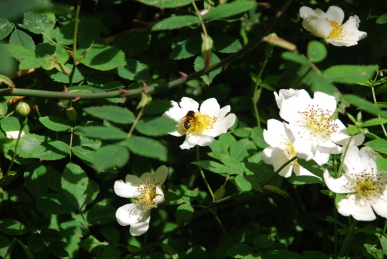 a metal gate railing. Over another stream and then a kerb appears in the path, which widens and becomes a road into The Knowle, previously simply Shepley Knoll. I have a chat with an elderly lady who is tending her garden. The lane, in an area of very nice old houses then becomes an industrial estate and leads out onto the A629. I head up the hill to the Black Bull Inn, but discover to my consternation it is closed! So I console myself with a pork pie and ginger beer from the Co-op. (This Co-op still operates a “divi” system based on locals having a local dividend number.) The lane leads to the station past Shepley Hall. Shepley is Anglo-Saxon for a “clearing with sheep”. Sceaplei is recorded in the Domesday Book. There is an inscription above the door of the hall, which I think says “Anno Domini 1608” although it is very eroded.
a metal gate railing. Over another stream and then a kerb appears in the path, which widens and becomes a road into The Knowle, previously simply Shepley Knoll. I have a chat with an elderly lady who is tending her garden. The lane, in an area of very nice old houses then becomes an industrial estate and leads out onto the A629. I head up the hill to the Black Bull Inn, but discover to my consternation it is closed! So I console myself with a pork pie and ginger beer from the Co-op. (This Co-op still operates a “divi” system based on locals having a local dividend number.) The lane leads to the station past Shepley Hall. Shepley is Anglo-Saxon for a “clearing with sheep”. Sceaplei is recorded in the Domesday Book. There is an inscription above the door of the hall, which I think says “Anno Domini 1608” although it is very eroded.
Tuesday 8th July – Home – July continues with very changeable weather – sunshine, clouds, rain and relatively low temperatures. The roses around the gardens have responded well to these conditions and given a gorgeous display. The vegetable plot though seems slow, lettuces growing at a snail’s pace, which is tempting fate although it is the Wood Pigeons that do the damage. The courgettes are doing well, pushing out new leaves quickly now. The beans are climbing the poles and both chard and beetroot have germinated. The chickens all laid an egg each today, the first time this has happened, Freckles being the last to come into lay! And we have now established that Spotty lays double yolkers.

Friday 11th July – Kelk – Off the annual Moonbeams Acoustic Music Gathering at Kelk in East Yorkshire. For once we are not the first of our crowd to arrive! The tent is erected and a beer opened before we adjourn to the barn for the evening sing-around. There are some very talented singers and musicians here, all amateur, and admittedly one or two whose enthusiasm exceeds their ability. Wold Top beer on draught and a fine chilli courtesy of Mick McGarry – what more could one want? We finish around midnight and totter off to bed. Awake in the middle of the night to the sound of heavy rain pounding the tent.
Saturday 12th July – Kelk – A Blackbird starts singing at dawn, i.e. before four in the morning. By the time I emerge from the tent, a Greenfinch is wheezing in the hedge and gulls are squabbling overhead. 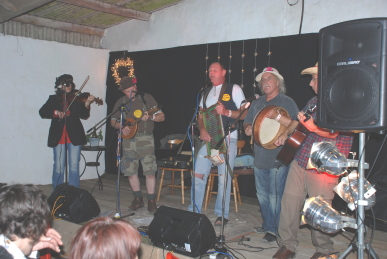 I sit outside the tent with a cup of tea. A cock Pheasant lands beside me and struts around until he realises I am there and runs off across the field looking more like a cartoon bird than the real thing. Swallows sweep low across the clover strewn grass. We decide that a morning of idleness is called for, although we expend energy going in and out of the tent as frequent heavy showers pass over. The music starts at two o’clock in the afternoon and goes on long after we retreat, satiated. Again, I am struck about the sheer quality of the acts on display. The Flivvers deliver their usual excellent set led by Digby on washboard and vocals. Our friends Dave and Zöe are in fine form. Back at the tents we devour curries and naan bread whilst bats jink over our heads.
I sit outside the tent with a cup of tea. A cock Pheasant lands beside me and struts around until he realises I am there and runs off across the field looking more like a cartoon bird than the real thing. Swallows sweep low across the clover strewn grass. We decide that a morning of idleness is called for, although we expend energy going in and out of the tent as frequent heavy showers pass over. The music starts at two o’clock in the afternoon and goes on long after we retreat, satiated. Again, I am struck about the sheer quality of the acts on display. The Flivvers deliver their usual excellent set led by Digby on washboard and vocals. Our friends Dave and Zöe are in fine form. Back at the tents we devour curries and naan bread whilst bats jink over our heads.
Tuesday 15th July – Burncross – One of the villages on the northern edge of Sheffield. They are more or less a continuous conurbation now. An inn stands on the crossroads. Just down Hollowgate is the old smithy, now a private house. Hallwood Road is a mixture of old cottages and 20th and 21st century houses. A row of cottages built of blackened stone, witness to the pollution that covered the whole Sheffield area when the city was the steel centre of England, gives way to 20th century semis. The road then enters Low Hall Wood and a footpath leads off into the woods. Robin Hood Well is nearby according to the map, but there is little to see. The path winds through the wood. There are clearings on either side, one dense with conifer saplings, the other covered in bracken and Rosebay Willowherb. A small valley carries Hall Wood Dike. Stones make crossing the stream easy and the footpath rises to some stone steps which carry the path out of the woodland and through fields to Near Potter Hill, once a hamlet, now part of High Green. Potter Hill is to the north but I turn south down Potter Hill Lane. The road leads back down, past Charlton Terrace to Charltonbrook at the bottom of Hollowgate.
Thursday 17th July – Hope Under Dinmore – We are house hunting again in the Leominster region. A hopeful place with the River Arrow at the bottom of the garden was rejected as the rooms were simply too small. So we are now in the tiny village of Hope Under Dinmore, south of Leominster. Dinmore is a huge wooded hill that dominates the landscape. A stream runs down a valley west of the hill and on the rise up from the stream, further to the west is a block of old Alms Houses. Two are for sale and we view them both. They are delightful with huge gardens. However, to get in and out of the village one must negotiate the A49, a very busy and fast trunk road. This is a bit off-putting. So we return to Leominster and the Chequers pub to consider our options.
Friday 18th July – Leominster – We are camping in a site behind the Barons Cross Inn. The pub had a bad reputation in the past but has been taken over by a family who are determined to make it into a successful family pub. The site is basic but suits our needs. I am awake early, Rooks calling and fluttering around outside the tent does not help. We head into Leominster. The Friday market is in full swing. One of the butchers in the town has closed, as have a couple of other shops and unfortunately, one of the premises has been taken over by a fast food dispenser. However, most of the shops that make the town such a delight are still here. We head back down to Dinmore and travel along narrow country lanes. At the end of one is a farm selling poultry supplies – a useful find. We have a look at another cottage, again possibly an old Alms House, but it is several miles from a bus route and would make car travel essential. Into Newton Cidery but we can find no-one apart from a very friendly Border Collie who looks distraught when we leave. Back in Leominster we look at another couple of houses. The second, an old coach house, is delightful and we decide this could well be the one.
Tuesday 22nd July – Stainborough – After several days of decision making we have put in an offer for the house and it has been accepted. I head out for a short walk and end up at an industrial estate at Stainborough. A track leads up the hill, once called Smithy Wood Lane. Great and Rosebay Willowherbs are in flower along with many others. Large leaves of Coltsfoot, who flowers came and went before the leaves emerge, are common in the rough ground. The track meets the old Worsbrough-Penistone railway line, the South Yorkshire Railway, Darley Main and Old Silkstone Branch. There is considerable construction taking place. The track has been partitioned and a large pound has been created for construction offices and materials. Further on a large area of land has been cleared. This is above where the old Lowe Reservoir once lay. A path leads down behind the industrial estate. It passes through a small wood where some badly wormed boletus fungi are rotting away. Also present are large russula fungi, wide brown inverted caps and brown gills. The path bends around over a deep little valley that carries a stream, once the millrace for Stainborough Corn Mill, now a private dwelling. The water is coloured orange by outflow from the industrial estate. Blackcaps hop though the trees and a Chiffchaff calls. A footpath leading to an old bridge across the stream is closed as the bridge is in a bad state of repair. A flight of Linnets twitter over. Raspberry canes give a nibble of fruit. Back near the road is a piece of waste ground covered in Dock, Melilot and St Johns Wort. Meadow Brown and Gatekeeper butterflies are flitting through the flowers.
Saturday 26th July – Home – An unpleasant start to the day – a pile of feathers and only three chickens. It looks like a fox has taken Goldie. I can only speculate how this has happened, either she did not go to roost before the automatic door closed or the door opened quite early in the morning, being light controlled, and the fox was still active. Either way it looks like I need to temporarily disable the automatic door and manually close them in. In the evening we sit in the garden. Gangs of screaming Swifts race over; occasionally one will spin over in the air. The gangs break up into smaller groups and singles then reform. They then depart for the night. A thin cloud of gnats is hovering above our heads. Something, a hedgehog almost certainly, is snuffling and rustling down behind the wide flower border next to the wall. A bat jinks through the garden, to and fro and then off over the wall.
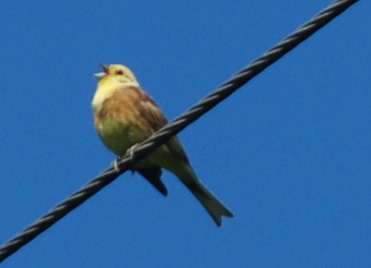
Tuesday 29th July – Kendal Green – From the car park on the Trans-Pennine Trail at Worsbrough a track leads up to a farm. The track was called Calf Croft Green Lane and the farm, Kendal Green. The latter name now applies to the large estate of mainly bungalows that spreads out from Vernon Road. The track is lined with summer flowers – Willowherbs, Hogweed, Tufted Vetch, Ragwort and Bindweed. Elder has a fine display of little green elderberries. A Yellowhammer is singing his “A-Little-Bit-Of-Bread-And-No-Cheeeeeeese” song. The path passes the farm and a lovely cottage with arched windows and a stepped chimney flue running right up the end wall. Over a stile and into a wheat field which has already been harvested and the straw has been baled. Wrens  and Blackbirds flit around the hedgerow. This is mainly Hawthorn covered with Cleavers – Sticky Weed or Goosegrass and many other names. There is a scrape in the surface of the field where the harvester has hit soil containing a lot of small bits of rubble – possibly the only remains of Prince Albert Colliery, which stood here. It had closed before the end of the 19th century. Coal pits, an early form of open-casting, stood on the other side of the path but now there is just a few trees and a hedge leading off down the hill. Meadow Browns, Gatekeepers and several varieties of Whites flutter along the hedgerow. Grasshoppers rasp in the stubble. A beautiful Sycamore (or one of Maples) stands in the field. Ouselthwaite Hall and Stainborough House face each other across the valley. The path reaches Houndhill Lane at Calf Croft Green. There is a large white, flat-roofed house here, looking very art deco, but is probably
and Blackbirds flit around the hedgerow. This is mainly Hawthorn covered with Cleavers – Sticky Weed or Goosegrass and many other names. There is a scrape in the surface of the field where the harvester has hit soil containing a lot of small bits of rubble – possibly the only remains of Prince Albert Colliery, which stood here. It had closed before the end of the 19th century. Coal pits, an early form of open-casting, stood on the other side of the path but now there is just a few trees and a hedge leading off down the hill. Meadow Browns, Gatekeepers and several varieties of Whites flutter along the hedgerow. Grasshoppers rasp in the stubble. A beautiful Sycamore (or one of Maples) stands in the field. Ouselthwaite Hall and Stainborough House face each other across the valley. The path reaches Houndhill Lane at Calf Croft Green. There is a large white, flat-roofed house here, looking very art deco, but is probably 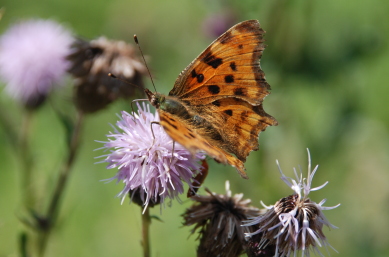 post-Second World war. Down the road the land towards Houndhill House drops away from the road – an old sandstone quarry was here. The house (history) is unfortunately hidden behind walls and tall hedges. The lane drops down towards the valley carrying the M1 motorway. It crosses the railway and I drop down onto the track. It is interesting to note that the pathway is now relatively narrow compared with twenty years ago when it was still the full width of the old railway. Many thistles, Ragworts, Knapweeds and others are in flower providing good feeding for many insects, including bees, hoverflies, “bloodsuckers” and Comma butterflies. A Song Thrush dust-bathes on the clinker track.
post-Second World war. Down the road the land towards Houndhill House drops away from the road – an old sandstone quarry was here. The house (history) is unfortunately hidden behind walls and tall hedges. The lane drops down towards the valley carrying the M1 motorway. It crosses the railway and I drop down onto the track. It is interesting to note that the pathway is now relatively narrow compared with twenty years ago when it was still the full width of the old railway. Many thistles, Ragworts, Knapweeds and others are in flower providing good feeding for many insects, including bees, hoverflies, “bloodsuckers” and Comma butterflies. A Song Thrush dust-bathes on the clinker track.